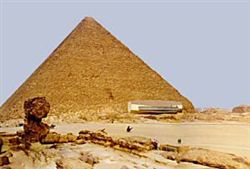
Name of the necropolis to the southwest of Cairo, forming part of the huge cemetery of the ancient residence Memphis. There are mastabas here from as early as the 1st Dynasty, but the area is mainly famous for the three pyramids from the 4th Dynasty and their surrounding mastabas for members of the royal family and high officials. After Seneferu had built the first true pyramid in Dahshour, his son Khufu built his tomb in Giza, the largest known pyramid, constructed of more than 3 million blocks of limestone and originally completely covered in a smooth layer of white limestone from Tura. The pyramid has an unfinished underground room, usually regarded as the original planned burial chamber; after changes to the plan, two further burial chambers were constructed in the superstructure, usually called the King's Chamber and the Queen's Chamber. Both rooms are supplied with upwards sloping shafts, previously considered to be ventilation shafts; nowadays an astronomical purpose is assumed. In 1993 a mobile camera was sent into one of these shafts, which resulted in the discovery of a closed door leading to speculations concerning an as yet unknown fourth chamber. Close to the pyramid of Khufu are the remains of his mortuary temple, linked to a (vanished) valley temple by a processional way. Further, there are various large pits intended for boats, in two of which boats have actually been found. Nearby is the tomb of Hetepheres, the mother of Khufu; there are also several subsidiary pyramids, regarded as being intended for queens. The most southerly of them became a cult area for the goddess Isis from the 3rd Intermediate Period on.
The second pyramid was built by Khephren. Although it is slightly smaller, it appears to be larger because it is built on a rise in the plateau. A processional way runs from this pyramid to a well-preserved valley temple made of granite. Next to it is the Sphinx of Giza. Because of its location next to Khephren's valley temple and processional way, it is assumed that the Sphinx was carved by this pharaoh and displays his portrait. In the 18th Dynasty, a temple to Harmakhis ('Horus in the Horizon') was built here by Amenhotep II, expanded by Sethos I in the 19th Dynasty.
The third, much smaller, pyramid is that of Menkaure. The famous statues of this king, triads with Hathor and various nome gods and goddesses, were found in his mudbrick valley temple. In the 26th Dynasty, probably in connection with the need to turn to older times in art and religion, the pyramid was restored; at this time a wooden sarcophagus was left in the pyramid, originally a source of confusion for Egyptologists who thought that they had found the remains of the original burial of Menkaure.